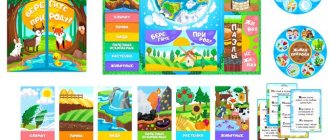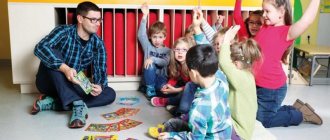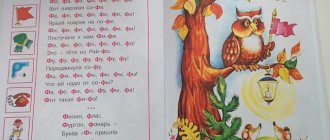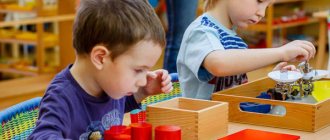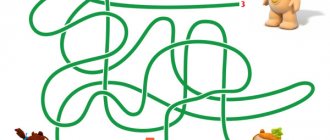Finding errors and inconsistencies
These tasks are an excellent tool for training attention and it is not important that the child learns not to immediately take the information received on faith, but to think for a while.
For such tasks, you can use fable pictures (for non-speakers) or in the form of fable poems, for example:
- Sasha ate soup, so he is hungry;
- Ilona couldn’t come home, so she forgot her keys, etc.
By the way, such tasks are very useful for correcting agrammatisms and developing a full understanding of speech.
Comparison (similarities/differences)
This is another complex mental operation that becomes accessible to children aged 5+. Start by completing tasks with pictures, then gradually move to the verbal level so that the child moves away from visual support to imaginative thinking, which puts the necessary load on memory and imagination.
You can come up with exercises yourself - just ask your child what, for example, a table and a chair have in common. In response you may hear, for example: 4 legs, made of wood, this is furniture and more. Then ask him what the differences are between them, for example, they sit on a chair, but not on a table. The chair has a back, but the table does not, etc.
This is a simple task, but it helps the child conduct an in-depth analysis of what he sees, notice similarities and differences in the smallest details.
Mathematics is an equally important subject that helps children who have problems with speech and imitation. But even without such violations, it should not be neglected, because this science moves the brain and promotes the development of logical thinking.
Written examples can be used for children who find it difficult to speak, and for children with extensive speech, you can come up with simple tasks on the fly that all children from 6-7 years old can do.
If you want your child to listen to you more carefully, come up with examples with stories that are fascinating to him. For example, my daughter really loves beautiful dolls, so she enjoys solving problems related to this topic: “There were 10 dolls on the store counter, 2 of which were previously put aside by the buyer. How many dolls are left for sale?
To develop your child’s imaginative thinking and stimulate memory, periodically ask questions like:
- How many legs does a dog have?
- How many tails does a mouse have?
- How many toes are there on both feet?
Logical puzzles for ingenuity
Task
There are three lamps hanging in the room. In the next room where you are, there are 3 switches. The rooms are separated by a light-proof door. Question: how to determine which switch turns on and off which lamp, if you can only enter the room with lamps once, and at that moment you cannot touch the switches.
Answer
You must first turn on one (first) switch for 5-10 minutes, after which one light bulb will become hot. Then you need to turn off this switch and turn on any other of the remaining 2 (this is the 2nd switch). And immediately go into the room. The lamp is not turned on, but is still hot, and is turned on by the first switch. The lamp is turned on by the second switch. And the remaining switched off lamp is turned on by the last switch.
Task
Make one word from the given set of letters.
L O S O N D O O V
Answer
ONE WORD. That is, you need to compose “one word”, and this is how you get “one word” from a set of letters.
Task
The pilot jumped out of the plane without a parachute. How was he able to remain unharmed after landing on solid ground?
Answer
The plane was standing on the runway.
Task
There are two traffic police inspectors standing by the road. One looks up the road to see if a car is approaching from the north, and the other looks down the road to see if a car is approaching from the south. Suddenly one asks the other: “Why are you smiling?” How could he know that the other inspector was smiling?
Answer
The inspectors stood not back to back, but facing each other.
Task
Katya's father had 7 daughters and no sons. The six daughters' names are: Nana, Nene, Nini, Nono, Nunu, Nene. What is the name of the seventh daughter?
A) Nurse.
B) Nanny.
B) Nane.
D) Zhana.
D) There is no correct name in the list of answers.
Answer
D). The seventh daughter is Katya (see the problem statement).
Task
A tool for measuring time with a minimum number of moving parts is a sundial. Which timing instrument has the maximum number of moving parts?
Answer
Hourglass. Falling grains of sand are moving elements and there are a lot of them.
Task
Three students were late for the lecture. They explained their delay by saying that they were traveling together in the same car and on the way they got a flat tire. How was the teacher able to quickly prove that they were lying?
Answer
The teacher asked each student separately (in a separate room) which tire was flat. All three students pointed to different wheels.
Task
Many of you have seen bottles of alcohol in liquor stores that also contain some large ripe fruit inside: an apple, a pear, etc. Now tell me how to place a fairly large ripe fruit (not dried) into such a bottle with a narrow neck without damaging it. without dividing it.
Answer
Very simple. The bottle is tied to a fruit tree and when the fruit is just beginning to grow, it is placed in this bottle without being removed from the branch.
Task
The beetle crawls up a tree, and during the day, in the morning, afternoon and evening, it crawls to a height of 5 meters, and at night it descends to 2 meters. Question: on what day and time will the beetle crawl to a height of 9 meters if it started crawling onto the tree on Sunday at 6 o’clock in the morning?
Answer
Very often they reason like this: a beetle crawls to a height of 3 meters (5m - 2m) in 24 hours. Therefore, he will climb to a height of 9 meters in 3 days, i.e. by 6 a.m. Wednesday. But the more correct answer is different: at the end of the second day (Tuesday at 6 am) the beetle will be at a height of 6 meters, and on the same day it can crawl another 5 meters, which exceeds the required level of 9 meters. It is not difficult to calculate that the beetle will reach 9 meters on Tuesday at 13:12.
Task
4 students live in one dorm room. Moreover, they all study at different times. They installed 4 padlocks on the door, the key for each does not fit the other 3 locks. How can students open the door and enter the room if each of them only has their own key and they return from study at different times when the other three students are not there? In the absence of students, the door is closed with these four locks.
Answer
The students arranged the padlocks as follows: the first is installed on the left hinge of the door, and the fourth lock is on the right, and all four locks are intertwined in series. Those. The first lock connects the left loop and the second lock, the second lock connects the first and third, the third lock connects the second and fourth, the fourth lock connects the third and right loop. Opening any of the locks will open the door.
Task
A man must transport a wolf, a goat and a cabbage from one bank of the river to the other in a boat. But in addition to a person, only 1 character can fit in the boat. In the presence of a person, no one eats anyone, but if you leave a wolf and a goat alone, then the wolf eats the goat, if you leave cabbage and a goat alone, then the goat will eat the cabbage. How can a person transport all three characters without anyone eating anyone?
Answer
First the man must transport the goat; the wolf does not eat cabbage. Next, he transports the cabbage and immediately takes the goat back, after which he transports the wolf and leaves him with the cabbage. Then he transports the goat.
Task
Two cyclists rode towards each other, one from point A, the other from point B. When 300 km remained between them, a bird noticed them and began to fly from the first cyclist to the second and vice versa until they met. The bird flew at a speed of 100 km/h, and the cyclists rode towards each other in a straight line at equal speeds of 50 km/h. How many kilometers did the bird end up flying between the cyclists?
Answer
At first glance, it seems that the task is quite complicated, but if you read the task carefully, it will become clear that the bird flew 300 km. Solution: the bird flew until the cyclists met. They will travel 300 km at a total speed of 100 km/h in 3 hours. Consequently, the bird also flew for 3 hours at its speed of 100 km/h.
Task
The girl dropped her ring into a cup full of coffee. Why did the ring remain dry?
Answer
The coffee was in beans: ground or instant.
Task
There is a rich house and a poor one. They are burning. Which house will the police extinguish?
Answer
Police don't put out fires, firefighters put out fires.
Task
You enter a dark kitchen. It contains a candle, a kerosene lamp and a gas stove. What will you light first?
Answer
Match
Task
How can a thrown egg fly three meters without breaking?
Answer
You need to throw the egg four meters, then the first three meters it will fly intact.
Task
The train travels at a speed of 70 km/h. Which direction will the smoke fly?
Answer
The train has no smoke.
Task
Where were potatoes first discovered?
Answer
In the ground.
Task
Name five days without naming them by numbers or by the names of the days of the week.
Answer
The day before yesterday, yesterday, today, tomorrow, the day after tomorrow.
Task
Without what can nothing ever happen?
Answer
Untitled.
Task
What do they always talk about in the future tense?
Answer
About tomorrow.
Task
How can you bow your head without lowering it down?
Answer
By cases.
Task
Do not write anything or use a calculator. Take 1000. Add 40. Add another thousand. Add 30. Another 1000. Plus 20. Plus 1000. And plus 10. What happened?
Answer
(5000? Incorrect. The correct answer is 4100. Try using a calculator).
Analogies and Antonyms
Analogies help to update your vocabulary and find logical connections between words:
- the fork is for eating, and the knife is for…(cutting);
- boots are shoes, and shorts are...(clothing);
- It’s cold in winter, and ... (warm) in summer, etc.
Antonyms:
- thick – thin;
- cold - warm;
- harmful - useful;
- evil - good, etc.
These words and phrases are given as an example; you can come up with something of your own, but you need to select them depending on the child’s individual level of knowledge.
Fourth wheel
Ask your child what is unnecessary, then ask them to justify it. For example:
- sundress, shirt, boots, fur coat (boots - shoes);
- cabbage, plum, eggplant, beet (plum is a fruit);
- pig, wolf, fox, deer (pig is a domestic animal);
- chest of drawers, cabinet, wardrobe, sofa (sofa - upholstered furniture).
In this case, more complex categories are again used than at the previous stage, since the child must know more about the world around him.
